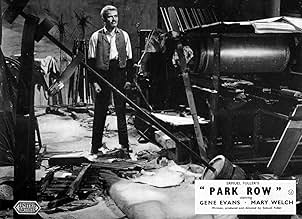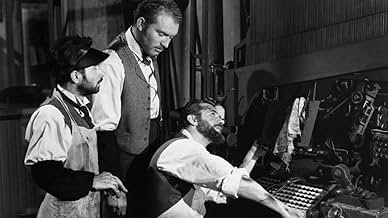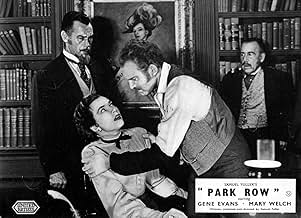अपनी भाषा में प्लॉट जोड़ेंThe Globe is a small, but visionary newspaper started by Phineas Mitchell, an editor recently fired by The Star. The two newspapers become enemies, and the Star's ruthless heiress Charity Ha... सभी पढ़ेंThe Globe is a small, but visionary newspaper started by Phineas Mitchell, an editor recently fired by The Star. The two newspapers become enemies, and the Star's ruthless heiress Charity Hackett decides to eliminate the competition.The Globe is a small, but visionary newspaper started by Phineas Mitchell, an editor recently fired by The Star. The two newspapers become enemies, and the Star's ruthless heiress Charity Hackett decides to eliminate the competition.
- Jenny O'Rourke
- (as Tina Rome)
- Barfly
- (बिना क्रेडिट के)
- Barfly
- (बिना क्रेडिट के)
- Irate Liberty Fund Contributor
- (बिना क्रेडिट के)
- Barfly
- (बिना क्रेडिट के)
फ़ीचर्ड समीक्षाएं
The plot of "Park Row" is relatively thin. Gene Evans is the newspaper man who becomes the editor of a crusading newspaper in opposition to the more powerful paper from which he's just been fired. It is, in other words, a feelgood movie about a David triumphing over a mean old Goliath, (in this case represented by Mary Welch's excellent performance as the owner of the rival paper), but it's a populist picture with none of the sentimentality that Capra would have brought to it. Indeed, being a Sam Fuller picture, there's a fair amount of violence en route to the happy ending. It also has one of Fuller's best scripts; this is a movie full of crisp dialogue that makes great use of factual material. Amazingly, despite it's substantial critical reputation, it's seldom revived. Time, I think, to rectify that.
Never did Fuller create a film of such sheer energy and nostalgia. The film's tracking shots and frenetically-edited montages seem to get the most attention, but there are also some great monologues and magnificent performances, particularly from Mary Welch as the head of the "evil" newspaper, The Star, and Gene Evans as the leader of their opposing newspaper, The Globe.
The film has it's moments of campiness, but overall it's one of cinema's overlooked classics.
The story is about a guy who is fired from one New York newspaper and decides to start his own. However, the deck is definitely stacked against him and a tough female newspaper owner seems willing to do anything to see his paper fail--and she takes this competition very personally. At first, she laughs off his attempts to put out a paper. But, when he starts seeing success after success, the competition becomes very dirty. In fact, the ugliness of this fight surprised me...it was THAT tough!
The film has some amazingly good camera-work--with great lighting and composition. It never looks cheap. Additionally, Evans is memorable as a tough guy who not only can out-think but out-punch his competition! His intensity is what makes the film. Overall, despite a few rough moments, it's a great textbook example that a film doesn't have to be expensive or filled with mega-stars to be a very good picture.
Our story proper begins in that most Fuller-ish of places, a saloon. There, a bunch of hacks on New York's bestselling daily, The Star, spends their evenings swilling booze and exchanging dreams and bitter bon mots. When idealistic reporter Gene Evans takes a break from the bar to nail an epitaph to the grave of an executed man that reads 'Murdered by The Star' – an acerbic bolt of pure fury from Fuller that's among the neatest things he ever did – the 'paper's owner (Mary Welch) marches in, sacking him and his chums on the spot.
So Evans starts up the 'paper he's always dreamt of – The Globe – and cheery, impressionable young buck George O'Hanlon throws himself off the Brooklyn Bridge for a laugh, giving him a first-rate first splash. But Welch doesn't take such competition lying down, especially not from a man she quite fancies, and so begins a circulation war that spills over into resentment, hatred and good old-fashioned violence.
As you would expect, Fuller has a real feel for the material, filling his script with the usual insider terminology and slang. Leaving just enough in his account for some vodka and cigars, the writer-director-producer spent the rest of his savings – some $200,000 accrued making hit war films – on this pet project. Much of the cash went on a fastidiously complete recreation of the Park Row of his memory, including a multitude of four-storey buildings. The film's designers queried his logic, saying the tops of the structures would never be seen on camera. Fuller said he didn't care: "I had to see it all. I had to know everything was there, exact in every detail." The sets are constructed in an ingenious way that allows Fuller's camera to wind his way through the nooks and crannies of the offices, the intensity of the shooting schedule belied by the wealth of innovation behind the camera. The director's crab dolly, a wheeled platform that allowed the camera to move in any direction, aids the spectacular direction, getting us up close and personal during Evans' periodic stomps up and down the titular street, generally looking for someone to thump.
Park Row is a punchy, sometimes dynamic blend of heartfelt sentiment and acerbic cynicism that could only have come from one director. Whilst it occasionally appears over-earnest or self-congratulatory, and has too much repetition across its 80 minutes, it's flavourful and immersive, with a no-name cast that ideally suits its ink-stained universe.
क्या आपको पता है
- ट्रिवियाDirector Samuel Fuller put up his own money to make the movie and lost it all.
- गूफ़Approximately 20 minutes into the film, there's a wall calendar showing the date as "1886 June 15 Monday." In 1886 June 15 was a Tuesday.
- भाव
Phineas Mitchell: The press is good or evil according to the character of those who direct it.
- क्रेज़ी क्रेडिटInstead of "The End", the picture ends with "Thirty"; newspaper jargon for "that's all. There ain't no more!"
- कनेक्शनFeatured in The Typewriter, the Rifle & the Movie Camera (1996)
टॉप पसंद
- How long is Park Row?Alexa द्वारा संचालित
विवरण
- रिलीज़ की तारीख़
- कंट्री ऑफ़ ओरिजिन
- भाषाएं
- इस रूप में भी जाना जाता है
- Park Row - Eine Zeitung für New York
- फ़िल्माने की जगहें
- उत्पादन कंपनी
- IMDbPro पर और कंपनी क्रेडिट देखें
बॉक्स ऑफ़िस
- बजट
- $2,00,000(अनुमानित)
- चलने की अवधि
- 1 घं 23 मि(83 min)
- रंग
- ध्वनि मिश्रण
- पक्ष अनुपात
- 1.37 : 1





















